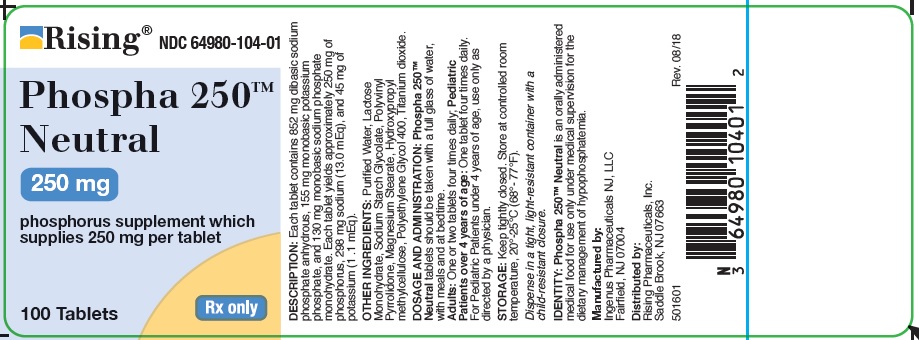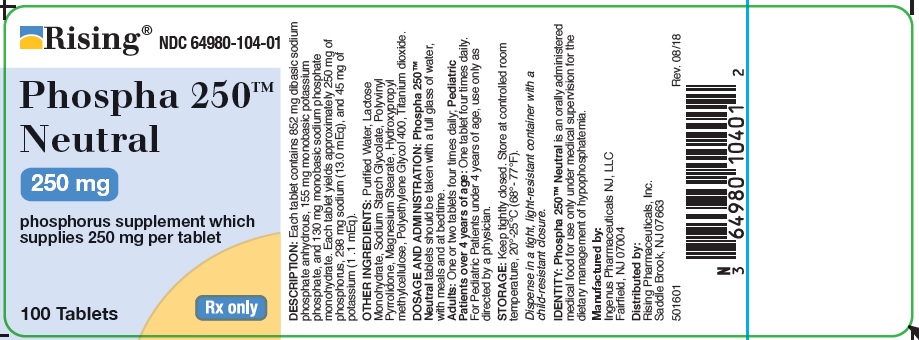Label: DIBASIC SODIUM PHOSPHATE, MONOBASIC POTASSIUM PHOSPHATE AND MONOBASIC SODIUM PHOSPHATE tablet
- NDC Code(s): 64980-104-01
- Packager: Rising Pharmaceuticals, Inc.
- Category: HUMAN PRESCRIPTION DRUG LABEL
- DEA Schedule: None
- Marketing Status: unapproved drug other
DISCLAIMER: This drug has not been found by FDA to be safe and effective, and this labeling has not been approved by FDA. For further information about unapproved drugs, click here.
Drug Label Information
Updated October 11, 2018
If you are a consumer or patient please visit this version.
- Download DRUG LABEL INFO: PDF XML
- Official Label (Printer Friendly)
- DESCRIPTION
- OTHER INGREDIENTS
-
CLINICAL PHARMACOLOGY
Phosphorus has a number of important functions in the biochemistry of the body. The bulk of the body's phosphorus is located in the bones, where it plays a key role in osteoblastic and osteoclastic activities. Enzymatically catalyzed phosphate-transfer reactions are numerous and vital in the metabolism of carbohydrate, lipid and protein, and a proper concentration of the anion is of primary importance in assuring an orderly biochemical sequence. ln addition, phosphorus plays an important rolein modifying steady-state tissue concentrations of calcium. Phosphate ions are important buffers of the intracellular fluid, and also play a primary role in the renal excretionof the hydrogen ion.
Oral administration of inorganic phosphates increases serum phosphate levels. Phosphates lower urinary calcium levels in idiopathic hypercalciuria.
In general, in adults, about two thirds of the ingested phosphate in absorbed from the bowel, most of which is rapidly excreted into the urine.
- INDICATIONS AND USAGE
- CONTRAINDICATIONS
-
PRECAUTIONS
General: This product contains potassium and sodium and should be used with caution if regulation of these elements is desired. Occasionally, some individuals may experience a mild laxative effect during the first few days of phosphate therapy. If laxation persists to an unpleasant degree reduce the daily dose until this effect subsides or, if necessary, discontinue the use of the product.
Caution should be exercised when prescribing this product in the following conditions: Cardiac disease (particularly in digitalized patients); severe adrenal insufficiency (Addison's disease); acute dehydration; severe renal insufficiency; renal function impairment or chronic renal disease; extensive tissue breakdown (such as severe burns); myotonia congenita; cardiac failure; cirrhosis of the liver or severe hepatic disease; peripheral or pulmonary edema; hypernatremia; hypertension; toxemia of pregnancy; hypoparathyroidism; and acute pancreatitis. Rickets may benefit from phosphate therapy, but caution should be exercised. High serum phosphate levels may increase the incidence of extraskeletal calcification.
Information for Patients: Patients with kidney stones may pass old stones when phosphate therapy is started and should be warned of this possibility. Patients should be advised to avoid the use of antacids containing aluminum, magnesium, or calcium which may prevent the absorption of phosphate.
Laboratory: Careful monitoring of renal function and serum calcium, phosphorus, potassium, and sodium may be required at periodic intervals during phosphate therapy. Other tests may be warranted in some patients, depending on conditions.
Drug Interactions:
The use of antacids containing magnesium, aluminum, or calcium in conjunction with phosphate preparations may bind the phosphate and preventits absorption. Concurrent use of antihypertensives, especially diazoxide, guanethidine, hydralazine, methyldopa, or rauwolfia alkaloid; or corticosteroids, especially mineralocorticoids or corticotropin with sodium phosphate may result in hypernatremia. Calcium-containing preparations and/or Vitamin D may antagonize the effects of phosphates in the treatment of hypercalcemia. Potassium-containing medication or potassium-sparing diuretics may cause hyperkalemia. Patients should have serum potassium level determinations at periodic intervals.
Carcinogenesis, Mutagenesis, Impairment of Fertility:
No long term or reproduction studies in animals or humans have been performed with PHOSPHA 250TM NEUTRAL to evaluate its carcinogenic, mutagenic, or impairment of fertility potential.
Pregnancy:
Teratogenic Effects. Pregnancy Class C. Animal reproduction studies have not been conducted with PHOSPHA 250 TM NEUTRAL. It is also not known whether this product can cause fetal harm when administered to a pregnant woman or can affect reproductive capacity.
This product should be given to a pregnant woman only if clearly needed.
-
ADVERSE REACTIONS:
Gastrointestinal upset (diarrhea, nausea, stomach pain, and vomiting) may occur with phosphate therapy. Also, bone and joint pain (possible phosphate-induced osteomalacia) could occur. The following adverse effects may be observed (primarily from sodium or potassium): headaches; dizziness; mental confusion; seizures; weakness or heaviness of legs; unusual tiredness or weakness; muscle cramps; numbness, tingling, pain or weakness of hands or feet; numbness or tingling around lips; fast or irregular heartbeat; shortness of breath or troubled breathing; swelling of feet or lower legs; unusual weight gain; low urine output; unusual thirst.
To report SUSPECTED ADVERSE REACTIONS, contact Ingenus Pharmaceuticals, LLC at 1-877-748-1970 or FDA at 1-800-FDA-1088 or www.fda.gov/medwatch
- DOSAGE AND ADMINISTRATION
- HOW SUPPLIED
- STORAGE
- IDENTITY: Phospha 250TM Neutral
- SPL UNCLASSIFIED SECTION
- PACKAGE LABEL.PRINCIPAL DISPLAY - 250 mg
-
INGREDIENTS AND APPEARANCE
DIBASIC SODIUM PHOSPHATE, MONOBASIC POTASSIUM PHOSPHATE AND MONOBASIC SODIUM PHOSPHATE
dibasic sodium phosphate, monobasic potassium phosphate and monobasic sodium phosphate tabletProduct Information Product Type HUMAN PRESCRIPTION DRUG Item Code (Source) NDC:64980-104 Route of Administration ORAL Active Ingredient/Active Moiety Ingredient Name Basis of Strength Strength SODIUM PHOSPHATE, DIBASIC, ANHYDROUS (UNII: 22ADO53M6F) (PHOSPHATE ION - UNII:NK08V8K8HR) SODIUM PHOSPHATE, DIBASIC, ANHYDROUS 852 mg POTASSIUM PHOSPHATE, MONOBASIC (UNII: 4J9FJ0HL51) (PHOSPHATE ION - UNII:NK08V8K8HR) POTASSIUM PHOSPHATE, MONOBASIC 155 mg SODIUM PHOSPHATE, MONOBASIC, MONOHYDRATE (UNII: 593YOG76RN) (PHOSPHATE ION - UNII:NK08V8K8HR) SODIUM PHOSPHATE, MONOBASIC, MONOHYDRATE 130 mg Inactive Ingredients Ingredient Name Strength WATER (UNII: 059QF0KO0R) LACTOSE MONOHYDRATE (UNII: EWQ57Q8I5X) SODIUM STARCH GLYCOLATE TYPE A POTATO (UNII: 5856J3G2A2) POVIDONE K30 (UNII: U725QWY32X) MAGNESIUM STEARATE (UNII: 70097M6I30) HYPROMELLOSE 2910 (15000 MPA.S) (UNII: 288VBX44JC) POLYETHYLENE GLYCOL 400 (UNII: B697894SGQ) TITANIUM DIOXIDE (UNII: 15FIX9V2JP) Product Characteristics Color WHITE Score 2 pieces Shape CAPSULE Size 9mm Flavor Imprint Code RIS;104 Contains Packaging # Item Code Package Description Marketing Start Date Marketing End Date 1 NDC:64980-104-01 100 in 1 BOTTLE; Type 0: Not a Combination Product 06/28/2012 Marketing Information Marketing Category Application Number or Monograph Citation Marketing Start Date Marketing End Date UNAPPROVED DRUG OTHER 06/28/2012 Labeler - Rising Pharmaceuticals, Inc. (041241766) Registrant - Ingenus Pharmaceuticals NJ, LLC (964680206) Establishment Name Address ID/FEI Business Operations Ingenus Pharmaceuticals NJ, LLC 964680206 MANUFACTURE(64980-104)


